Thursday 30 August 2012
The Tasmanian Pademelon - The Runway Makers
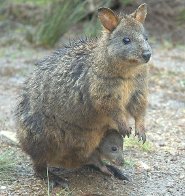
The
Tasmanian Pademelon (
Thylogale billardierii) is one of Australia's completely unique animals. Their Latin name translates to Billardière's pouched-weasel. The Pademelon is a stocky mammal that has gray to dark brown fur. These kangaroo-like animals possess shorter legs and tails than their distant relatives the Wallaby and Kangaroo have. The males are twice as big as the females. Males typically weigh in at an impressive 8 kilograms, or 17.6 pounds, while the females only weigh around 4 kilograms, or 8.8 pounds. There have been cases of males found as heavy as 12 kilograms, or 26.4 pounds. Similarly, female Pademelons have grown to weigh as much as 10 kilograms, or 22 pounds. These larger sized Pademelons are not common.
The Pademelons only live in Tasmania today. It is widely believed that they used to dwell on the Australian mainland before Europeans arrived, bringing other predators with them. The animals' habitats are mostly rain forests, forest gullies, and coastal scrub areas. Nocturnal animals by nature, Pademelons require the presence of clearings nearby in order to graze by night. They also need denser undergrowth in order to sleep during the day. The best place to actually see the Tasmanian Pademelon is in the Mt. William National Park of Tasmania. Here, dry woodlands and coastal heath are both preserved in the north east of Tasmania. Tasmanian Pademelons' ranges can be extremely large, covering 170 hectares, or 420 acres. These amazing animals will frequently travel as much as 2 kilometers, or 1.25 miles, through the forest on any given night. Yet, when they reach the edge of a forest, the Pademelons do not often come out farther than 100 meters, or 109 yards, in order to graze for food in patches of grass.
The Tasmanian Pademelons are vegetarians. They only feed on plants that grow lower to the ground. Included in their diet are green shoots, grasses, seedlings, shrubs, and herbs. Clearings tend to be richer in these types of foods on which they thrive. As they eat forestry industry planted seedlings, the Pademelons have come into conflict with foresters.
In Tasmania, the Pademelons have few predators. They are hunted by Eagles,
Tasmanian Devils, and
spotted quolls though. There used to be an abundance of Pademelons on the Australian mainland. This all changed with the introduction of the foxes brought from Europe. As the foxes multiplied, there were simply too many predators after them on mainland Australia, and they became extinct on the mainland. Because no foxes live in Tasmania, the Tasmanian Pademelon proves to be quite common there.
A unique feature of these Pademelons is their one of a kind runways that they create. These cleared tracks that they make through low lying vegetation are easily spotted. These animals generally turn out to be territorial and loners by nature. Once in a while, they are seen feeding near one another, though this is uncommon. The animals prefer to be alone, except for of course the mothers and their babies who depend on them for care.
Picture of the tasmanian pademelon by
PanBK, licensed under
GFDL
You can help spreading the word about this animal by liking it on facebook
Permanent Link
Monday 27 August 2012
The Loggerhead Sea Turtle; Male or Female?
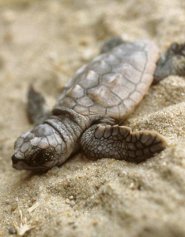
The
Loggerhead Sea Turtle (
Caretta caretta) has an enormous range. They live in all of the oceans of the world, Atlantic, Pacific, Indian and Mediterranean, except for the most frigid. Loggerheads favor coastal habitats but can have been known to travel far out to sea as well. They spend all of their lives in saltwater or estuarine habitats, except for a short time when the females come to land to lay their eggs. One of the features that distinguish the Loggerhead turtle as unique is the fact that there are no gender differences until the Loggerhead reaches adulthood. Another interesting feature of the Loggerhead turtle is that the female Loggerheads will often travel thousands of miles in order to lay their eggs at the same beach at which they were hatched. They do this with the help of a substance they have in their brains, magnetite (an iron compound), which allows the Loggerhead turtles to feel the magnetic field of the earth.
The Loggerhead turtle is an omnivorous reptile with a life span of 47-67 years. They range in size from around 31 to 49 inches (around 78 centimeters to 124.5 centimeters) and weigh around 170 to 315 pounds (around 77 kilograms to 142 kilograms). They feed on sea cucumbers, barnacles, crabs, shrimps, horseshoe crabs, sea urchins, conchs, fishes, octopuses, sponges, whelks, star fish, sea anemones, floating egg clusters, insects, flying fish, squids and jellyfish. Although the young have many predators, as do the eggs, once a Loggerhead becomes an adult their size limits their chance of becoming prey except to larger marine life such as sharks, parrotfish,
monk seals, moray eels and
killer whales.
The population of Loggerheads has declined by over 50% which makes the Loggerhead turtle an endangered species. Declining populations are due to the development of coastlines and beach disturbances by people such as cleaning, artificial lighting (discourages nesting and makes it hard for hatchlings to find their way to the water), fishing, driving and pollution. They are also hunted for food by some cultures as well as for their shells. High speed boat propellers are another killer as is the swallowing of trash such as fishing lines and plastic bags. Another cause of death is when Loggerheads get caught in fishing nets and drown for which the leading killer are shrimp and fish nets.
Conservation groups are trying to implement laws that will save Loggerhead turtles and get them off the endangered list.
You can help spreading the word about this animal by liking it on facebook
Permanent Link
Thursday 23 August 2012
The Northern Night Monkey - Nature's Malaria Lab
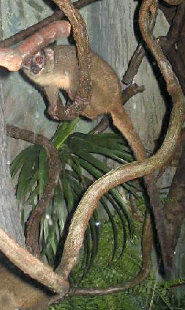
The
Northern night monkey (
Aotus trivirgatus), also known as the northern owl monkey, is an arboreal primate native to Venezuela and north-central Brazil. Its color is mostly black or brown with vivid white markings on the face. Body size is 24 to 47 centimeters (9.4 inches to 18.5 inches) with a tail length of about 22 to 42 centimeters (8.7 inches to 16.5 inches). Adults of both sexes weigh about one kilogram (2.2 pounds).
The northern night monkey lives in woodlands including tropical rainforest. It is omnivorous, eating a variety of small invertebrates, fruits, nuts, leaves and bird's eggs.
An unusual trait of the northern night monkey is that it can carry the same malaria parasite that effects humans, making it valuable for medical research. While its use for this purpose has allowed great strides in the treatment of the disease, it has also led to the capture of large numbers of night monkeys to be used as lab animals. Since the 1970's, there have been efforts to regulate this trade. While regulation is certainly in order, it cannot be denied that many human lives have been saved because of the medical work using this animal.
The taxonomy of the night monkey is still in dispute. Before 1983, all species of owl monkey were regarded as subspecies of A. trivirgatus. In 1983 genetic evidence revealed enough divergence between the subspecies to justify classifying them as separate species. This classification is still not universally accepted. As further research is conducted, the taxonomy will undoubtedly become more definite.
The northern night monkey is atypical among nocturnal animals in that it has color vision.
Nocturnal animals tend to be primitive species which have not evolved color vision, but the night monkey is more advanced and has apparently re-evolved nocturnality from diurnal ancestors. The night monkey's transition to nocturnality has been incomplete, for it still requires strong moonlight to see and is largely inactive on moonless nights.
Some of the indigenous peoples also hunt the night monkey as a game animal.
Unfortunately, enforcement of hunting regulations has been spotty due to rugged terrain, the local culture and lack of funding. There is undoubtedly much illegal hunting and trafficking of the animal still going on. At the moment, humans are the most dangerous predators of the northern night monkey.
However, the greatest threat to this animal is another human activity, destruction of the rain forest, which is wiping out large segments of its habitat.
Picture of the northern night monkey by
Stavenn, licensed under
GFDL
You can help spreading the word about this animal by liking it on facebook
Permanent Link
Tuesday 21 August 2012
Disk Tetra - Hates to be Alone
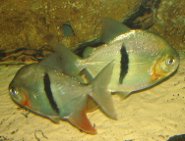 Disk tetras
Disk tetras (
Myleus schomburgkii), known in the pet trade as black-barred silver dollars and by ichthyologists as
Myleus schomburgkii, are larger than most aquarium fish but possess a fear of being alone. This is so pronounced that even if two or three are kept together, they may attack any other fish in the tank, including each other. Only by keeping them in small schools of at least five fish do they relax.
Why So Paranoid?
Although disk tetras are large in comparison to most tropical fish sold in the pet trade, they make tasty mouthfuls for predators in their native South America. They are eaten by numerous birds, reptiles, fish like the
giant arapaima and the incredibly rare
Amazonian River dolphin. The only defense against this constant bombardment of predators was to stay in large schools. That way, the individual fish has less of a chance of being eaten. Large schools can also stick close together to give the illusion that they are one very large fish instead of several smaller fish.
That’s a Big Fish
Tetras are usually less than an inch or 2.5 centimeters long, but not the disk tetra. They are one of the largest species of tetra known in the freshwater pet fish trade. Because they have a round body, they look more like silver dollars or Metynnis hypsauchen. Disk tetras can grow to a whopping 8.5 inches or 21.6 centimeters in length. Because of their size and that at least five are needed, disk tetras need to be kept in tanks that are at least 50 gallons or 189 liters large.
Diet
Disk Tetras are omnivores that can eat a wide variety of commercial fish foods. In the wild, they would eat small insects, zooplankton, corpses of other fish and river plants. In captivity, they can eat meat-based fish flakes and pellets. This can be the main diet, but they also need some variety in their meals. This can be from dehydrated or frozen brine shrimp, bloodworms or tubifex worms. They also enjoy grapes or spinach chopped into small pieces. Make sure the grapes and spinach are washed before chopping to remove any traces of pesticides.
You can help spreading the word about this animal by liking it on facebook
Permanent Link
Friday 17 August 2012
Raggiana Bird-of-Paradise
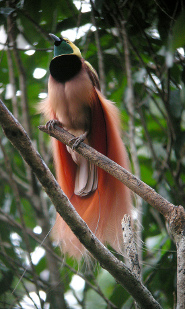
The
Raggiana Bird-of-paradise (Paradisaea raggiana) is a remarkably beautiful
bird that lives primarily in southern and northeastern New Guinea. While there are many different species in the same family as the Raggiana bird of paradise, Paradisaea raggiana is only found in these parts of New Guinea. In
Papua New Guinea, this bird is referred to as "kumul," and is the national bird of this country. Images of this bird of paradise are often found on money, stamps and it is also a representative of country's national rugby team. These birds belong to a larger family of birds classified as Paradisaeidae, and the males are well-known for their brightly colored feathers and plumage.
Paradisaea raggiana are typically around 34 cm (13 inches) in length, with some variation. These birds also tend to weigh between seven to twelve ounces, or about 3/4 of a pound or less. Males are very colorful, with wide variation in the colors of feathers, breasts, skin, and tail feathers. Males also tend to have a green area around the chin, with yellow coloring the head and neck. Females, in contrast, have less vibrant plumage and tail feathers. They tend to be mostly brown in color, which helps them avoid predators while raising their young.
Most often, these birds engage in polygamous mating relationships, although some birds do have one primary mate throughout their lives. Males gather in groups and display their colorful feathers in order to attract a female. Females usually lay two eggs at a time, with the incubation period lasting from 18 to 20 days. Nurturing and raising of the young is the responsibility of the mother.
The Paradisaea raggiana typically eat fruits and berries, although they are also known to eat small animals, such as frogs and lizards, as well as leaves. Unlike many birds, these birds of paradise do not migrate throughout the year. Rather, they find their home and stay in that same area throughout the year.
Although these birds have few natural predators, they are facing rapid deforestation in many areas of New Guinea. This destruction of their habitat has left many of these birds of paradise with no place to nest or live. Also, the birds were hunted by Europeans for many years after local peoples had told them that the birds were from the gods. However, today they are not an endangered species. In fact, they are actually quite numerous, and are considered to be of least concern of endangerment.
PIcture of the Raggiana Bird-of-Paradise by markaharper1, licensed under
Creative Commons Attribution-Share Alike 2.0 Generic license.
You can help spreading the word about this animal by liking it on facebook
Permanent Link
Tuesday 07 August 2012
The Pineapple Fish - Knight of the Ocean
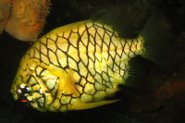 Pineapple fish
Pineapple fish (
Cleidopus gloriamaris) are an extremely unique marine specimen found in the coastal waters off of Western Australia, Queensland, and New South Wales. These fish are known to commonly inhabit deep water caves, up to 660 feet (200 meters) below the surface, as well as rocky ledges around shallower harbors and coral reefs.
Physically, the pineapple fish is a fascinating example of marine life. Their thick, rounded bodies can grow up to 9 inches (22 cm) long. Their scales are off-white to yellow in color with black lines along the rear of each one, creating the pattern from which its name is derived. The area around the mouth is predominantly black with a red line running along the lower jaw. Literally translated, its Latin name means "glory of the sea." Its nicknames include the "knightfish" and the "coat-of-mail fish" due to the pattern of inter-locking, armor-like scales covering its body which also resemble the outside of a pineapple fruit. These thick, heavy scales make the pineapple fish a relatively poor swimmer which contributes to the fact that they primarily reside in areas that are difficult for predators to access. Due to bioluminescent bacteria residing in pits at the corners of the fish's mouth, pineapple fish are also known as "port and starboard light fish." The light given off by these bacteria is generally green in young fish and begins to shift to a redder color as the fish ages. Late at night, they are known to venture out onto the sandy flats and use these lights to hunt for shrimp.
Because of the pineapplefish's primary habitat of secluded areas in deep water, and also its reclusive nature, there is little interaction with humans in the wild. Reef divers frequently report spotting these fish in shallower waters but have noted they are difficult to interact with or photograph, as they quickly retreat into the shadows under rocky ledges. The pineapple fish's nocturnal habits and its tendency to remove itself from the presence of any intruders into its environment have kept it from becoming a threatened or endangered species. For many years, the only specimens available for study were individuals that had been washed ashore. Pineapple fish occasionally find themselves in commercial fishing nets, and are frequently on display in the aquariums of fish enthusiasts, living up to ten years in captivity on a diet of live shrimp and small fish.
Picture of the pineapplefish by
richard ling, licensed under
Creative Commons Attribution-Share Alike 2.0 Generic license.
You can help spreading the word about this animal by liking it on facebook
Permanent Link
Thursday 02 August 2012
Harbor Porpoise
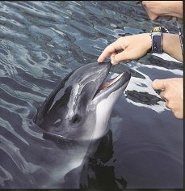
The
Harbor Porpoise Phocoena phocoena, is one of the smallest and the most elusive and shy creature among all oceanic cetaceans (the
vaquita is the smallest. Unlike other porpoises or dolphin species, the harbor porpoise does not like bow rides or approach boats. When the sea water is calm, one can easily detect these species as they make deafening puffing sound when they surface for breathing. As this species has an inshore habitat, it is among those cetaceans which can be studied well, and is hunted frequently for the same reason.
The harbor porpoise is small in size but plump and sturdy from the middle section and tapers towards its slender tail. It is hunted mainly because of its snout which is rounded and blunted without a specific beak. Its small mouth tilts a little upwards and has spade-shaped 22-28 small but sharp teeth on its upper jaw and 22-26 teeth in the lower jaw. Its maximum length is 1.9 m (6 feet) and maximum weight is approximately 90 kg (200 pounds). Most of the harbor porpoises are small and are only 1.5 m (5 feet) long. It is very rare for harbor porpoises to reach a 200-pound weight. An average harbor porpoise does not weigh more than 130 pounds. The females surpass males in size and are a little larger than the males.
The color of the back portion of a harbor porpoise is dark brown or gray. It has patches of light gray on both its sides and a white belly. The color of the flippers is also dark and there is a dark color strip extending from the eye to the flipper. Flippers of the harbor porpoise are small and oval-shaped with rounded tips. Its dorsal fin has a broad, triangular, and low base and is positioned a little behind the central part of the body. Sometimes, there are continuous small nodules on the outer edges of its dorsal fin. It has curved small flukes with a prominent medium touch.
The harbor porpoise becomes mature at the age of 3-4 years. Gestation period is believed to be 11 months and the female gives birth to the calves with an interval of two years. At birth, the weight of the calves is about 6.4-10 kg (14-22 pounds) and their length is 70-90 cm (27-35 inches). The mother nurses the calves for eight months.
The non-spiny fishes such as
cod, herring, squid, sardines, Pollock, and whiting are on the main menu of the porpoise. Although harbor porpoise is considered the smallest species in the porpoise family, it needs a good quantity of food everyday. It has been noticed to consume food as much as the tenth part of the weight of its body.
Generally seen in pairs or smaller groups of 6-10 animals, harbor porpoises have also been sited in groups of 50-100 while they were found to be actively feeding. This species has a tendency to often strand, probably because of its proximity to the shore areas. Some of these live stranded harbor porpoises are at times taken to several aquariums, but only a few have managed to survive while in captivity.
Picture by
Fjord&Bælt, licensed under
GFDL
You can help spreading the word about this animal by liking it on facebook
Permanent Link
Wednesday 01 August 2012
The Pyrenean Chamois - Nature's Acrobat
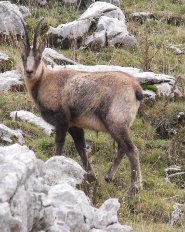
The
Pyrenean chamois (Rupicapra pyrenaica), sometimes known simply as chamois, pronounced "shammy", is a goat-like creature native to the mountain ranges of the Pyrenees, northwestern
Spain and the Apennines in central Italy. It's natural habitat is the high alpine meadows during the warmer part of the year, venturing down onto the slopes when the weather gets colder. They only very rarely will enter the forest.
The animal usually weighs between 24 and 50 kg, or 53 to 110 lbs. The average weight is about 37 kg, or 81 lbs. It has a length of 90 to 120 cm, or 35 to 51 inches, with an average length of 110 cm, or 43 inches. In the summer, its coat is reddish-brown and in winter it grows a much thicker brownish-black coat, with white markings. Both males and female have black horns that are close together and slender, rise vertically and then bend sharply to form hooks. They have padded and rather elastic hoofs, allowing them to keep their footing on otherwise treacherous terrain.
The Pyrenean chamois is nimble and known for its grace. It can jump nearly two meters, or approximately six feet, straight up into the air. It can also reach speeds of about 50 km per hour, or about 31 miles per hour, over rough and uneven ground. The chamois is also prized for its skin, which is made into a very soft and pliable leather which is popular for shining products. It is also hunted for meat and its dense winter fur.
For a time, the Pyrenean chamois population was in decline because of over-hunting and the animal was placed on the endangered list, but thanks to protective measures it is not currently at risk. The population and range of the chamois continue to increase. However, the subspecies R. p. ornata is still vulnerable and considered endangered at this time.
Other than humans, the Pyrenean chamois' natural predators include wolves, lynxes and fox. The chamois themselves feed on herbs and flowers during the summer. In the winter, they turn to moss, lichen and young pine shoots. When conditions become extremely difficult, chamois can fast for up to two weeks until food becomes available.
You can help spreading the word about this animal by liking it on facebook
Permanent Link
 The Tasmanian Pademelon (Thylogale billardierii) is one of Australia's completely unique animals. Their Latin name translates to Billardière's pouched-weasel. The Pademelon is a stocky mammal that has gray to dark brown fur. These kangaroo-like animals possess shorter legs and tails than their distant relatives the Wallaby and Kangaroo have. The males are twice as big as the females. Males typically weigh in at an impressive 8 kilograms, or 17.6 pounds, while the females only weigh around 4 kilograms, or 8.8 pounds. There have been cases of males found as heavy as 12 kilograms, or 26.4 pounds. Similarly, female Pademelons have grown to weigh as much as 10 kilograms, or 22 pounds. These larger sized Pademelons are not common.
The Tasmanian Pademelon (Thylogale billardierii) is one of Australia's completely unique animals. Their Latin name translates to Billardière's pouched-weasel. The Pademelon is a stocky mammal that has gray to dark brown fur. These kangaroo-like animals possess shorter legs and tails than their distant relatives the Wallaby and Kangaroo have. The males are twice as big as the females. Males typically weigh in at an impressive 8 kilograms, or 17.6 pounds, while the females only weigh around 4 kilograms, or 8.8 pounds. There have been cases of males found as heavy as 12 kilograms, or 26.4 pounds. Similarly, female Pademelons have grown to weigh as much as 10 kilograms, or 22 pounds. These larger sized Pademelons are not common.
 The
The  The
The 
 The
The 
 The
The  The
The